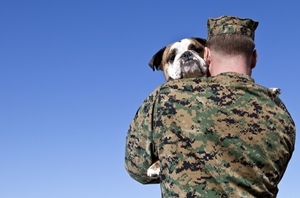Like many soldiers, Desert Storm veteran Phil Ruddock came home from deployment diagnosed with post-traumatic stress disorder. According to his testimonial, the symptoms became so severe that he could no longer work and would just sit at home, angry at the world. But his life changed when a friend brought him a scared, abused pitbull named Mia, and a partnership began.
As Ruddock trained Mia and gained her trust, she in turn would wake him up from nightmares and watch his back when he started to venture off his property again. Through this relationship, Ruddock realized that other vets dealing with PTSD could also benefit from incorporating service dogs into life after service.
Inspiration from experience
According to Small Business Revolution, Ruddock first started working with existing organizations that provide service animals. But the dogs were often expensive, sometimes carrying a price tag of up to $25,000. It did not make sense to Ruddock that soldiers returning from war with little money should have to pay such an extravagant sum for help. That is where the idea for Brothers and Sisters in Arms Dog Training began.
The nonprofit, founded by Ruddock, is based in Louisiana and aims to improve the life of military veterans, active duty soldiers and any special-needs dependents by providing them with trained service dogs, according to the Brothers and Sisters in Arms website.
Rather than breed dogs specifically for training, the organization uses calm, teachable shelter dogs that otherwise might be put down. It is a beautiful partnership between a person and a dog who are both looking for healing, and allows for the dogs to be given at no cost to the recipient, reported Small Business Revolution.
Creative hobbies can be a great way for veterans to deal with stress or depression.
Unlike the majority of service animal organizations, Brothers and Sisters in Arms actively involves the veterans in the training of their animals. By letting the owners train the dog, a stronger bond is created and the owner comes away with a sense of accomplishment that he or she may not have felt since coming back from active service.
Classes typically run eight weeks and involve the typical training for service dogs, as well as additional commands specifically aimed at helping combat veterans, reported Time magazine. These extra commands include teaching the dog to "block," or create space between their owner and others, and to "cover," or stand at their owner's side or back facing away as a kind of lookout. All classes are one-on-one and taught by veterans, creating a safe environment for the soldier.
Easing the transition
"When a soldier is deployed or on base, they feel secure because they have all the other soldiers there watching their back. But when they are out of the military, when their spouse goes to work, their kids go to school and they're left alone, they have nobody watching their back," Ruddock told Time. "It makes them very anxious, paranoid. A dog turns out to be their battle buddy and watches their back. It never leaves them, it never judges them, it never asks questions that they don't want to answer. It gives them unconditional love."
Through his work, Ruddock hopes to make a difference in the lives of military families, one soldier and dog at a time.

